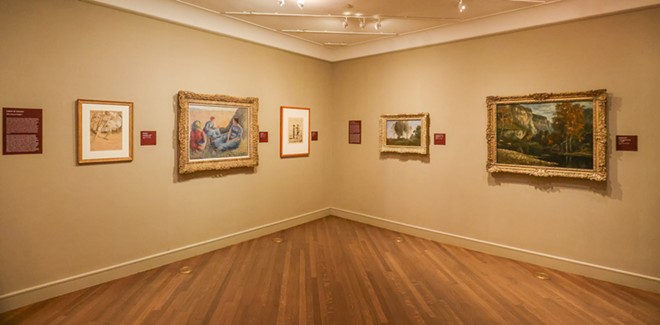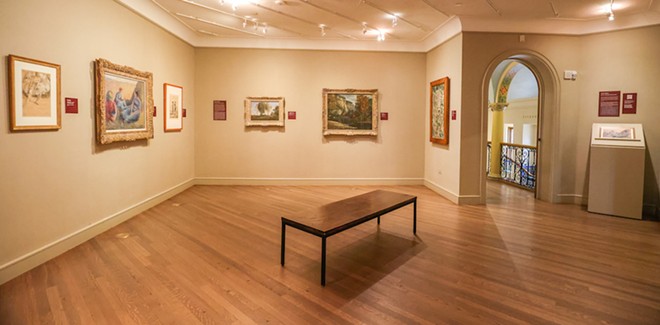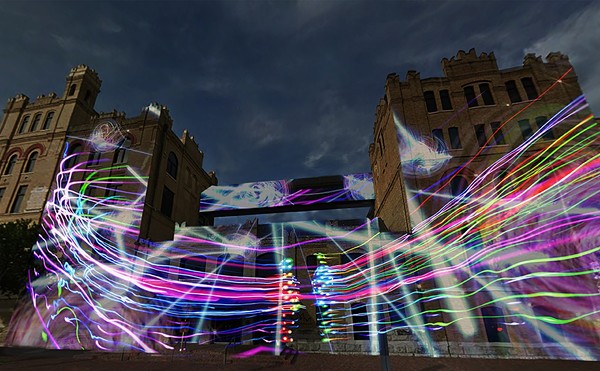
This year marks the 70th anniversary of the McNay Art Museum, home to more than 22,000 works of art, which fit largely within the framework of the European “canon.” However, the show “A Particular Beauty” highlights narratives and asks questions that have often been excluded from art-historical discourse.
The exhibition presents a small but considered selection of 19th century French prints, paintings and drawings from the museum’s permanent collection and shows them in a new light, using the works to reflect on a broad range of topics spanning ecocriticism, race, disability studies and other issues. It’s a small show, but it brings together a fine selection of blue-chip artists that carry serious weight.
“A Particular Beauty” is curated by Noelle Yongwei Barr, the McNay’s 2023/2024 Semmes Foundation Intern in Museum Studies. Featuring 12 works, the show is divided into four sections: Exoticism, Gendered Spaces, Leisure and Labor, and Bodies of Nature. Text on the wall poses questions such as “What is Exoticism?” and “Who has Privilege?”
On view for the first time at the McNay is an Odalisque by Ingres — pronounced sort of like “aang-gruh.” The print is a lithographic iteration of his famous painting of the same name in the Louvre. It depicts a languidly posing concubine situated with Oriental props.
Following Napoleon’s conquest of Egypt and Syria, and later France’s colonization of Algeria in 1830, many European artists loaded their paintings with fanciful references to Eastern cultures, a phenomenon writer Edward Said called “Orientalism.” Ingres’ Odalisque and Renoir’s adjacent Gabrielle in Oriental Costume together stand as a textbook examples of European portrayals of the exoticized “other.”
A trio of works in “A Particular Beauty” address the theme of gendered spaces.
Like many of his works, Degas’ depictions of women — such as the Bather, on view here — are uncomfortably voyeuristic, seeming to capture his dancers and bathers as if they were unaware of his — and our — presence.
However, an accompanying drypoint engraving by Berthe Morisot speaks to female agency. Morisot, whose luminous impressionist paintings were featured in seven of the eight original impressionist exhibitions in Paris, typically doesn’t appear in her own works. But in the little engraving The Drawing Lesson, we see her in the role of teacher, giving her daughter a sort of improvised art lesson. This at a time when art was still largely regarded as a gendered profession, and the ranks of the French Royal Academy of Art was almost entirely male. It’s a subtle work in which Morisot leans in to her roles both as a mother and an artist.
Several works address “Labor and Leisure” against the context of privilege, whether social, gender or economic, and we’re invited to consider that in their work, many of these artists approached labor from the comfortable vantage point of the bourgeois. It’s a tension we feel in Pissarro’s Haymakers Resting, one of the gems of the McNay’s collection, its flecks of paint rendered in the artist’s fastidious pointillist style.
But the image of three women prettily resting, backlit by a gorgeous sunlit field undermines the reality is that the trio is taking a break from doing seriously hard work. Millet’s more un-romanticized etching The Walk to Work is much more likely to resonate with us who battle the dreary morning commute on Loop 410.
The show concludes with a set of landscapes, and the show’s didactic text makes the point that these were created at a time when Paris was aggressively modernizing under Baron Haussmann and that Parisians of means found refuge in the countryside, certainly speaking to privilege. These large paintings by Corot, Courbet and Manet, all of who applied the paint in deliciously thick impasto, visually anchor the show with their commanding presence in the gallery space.
The exhibition has a couple tricks up its sleeve. It’s the McNay’s first show to be available on the app Bloomberg Connects, which makes the show’s works and accompanying essay and wall text completely available online. And in an effort to make the museum experience more inclusive, some wall text is provided in Braille, and a tactile experience that allows visitors to feel a textural representation of the loose brushwork of Pissarro’s Haymakers. Descriptive audio text and an exhibition catalog are available on the McNay’s website.
“A Particular Beauty” is a small show, but it’s ambitious in what it sets out to do. Perhaps it even tries a little too hard. Each of this exhibition’s four themes could probably be their own show. Even so, "A Particular Beauty" manages to take questions and ideas that have been circulating in academia and present them publicly in an accessible, engaging and eminently digestible way.
“A Particular Beauty” is on view at the McNay through June 16.
Subscribe to SA Current newsletters.
Follow us: Apple News | Google News | NewsBreak | Reddit | Instagram | Facebook | Twitter| Or sign up for our RSS Feed

















